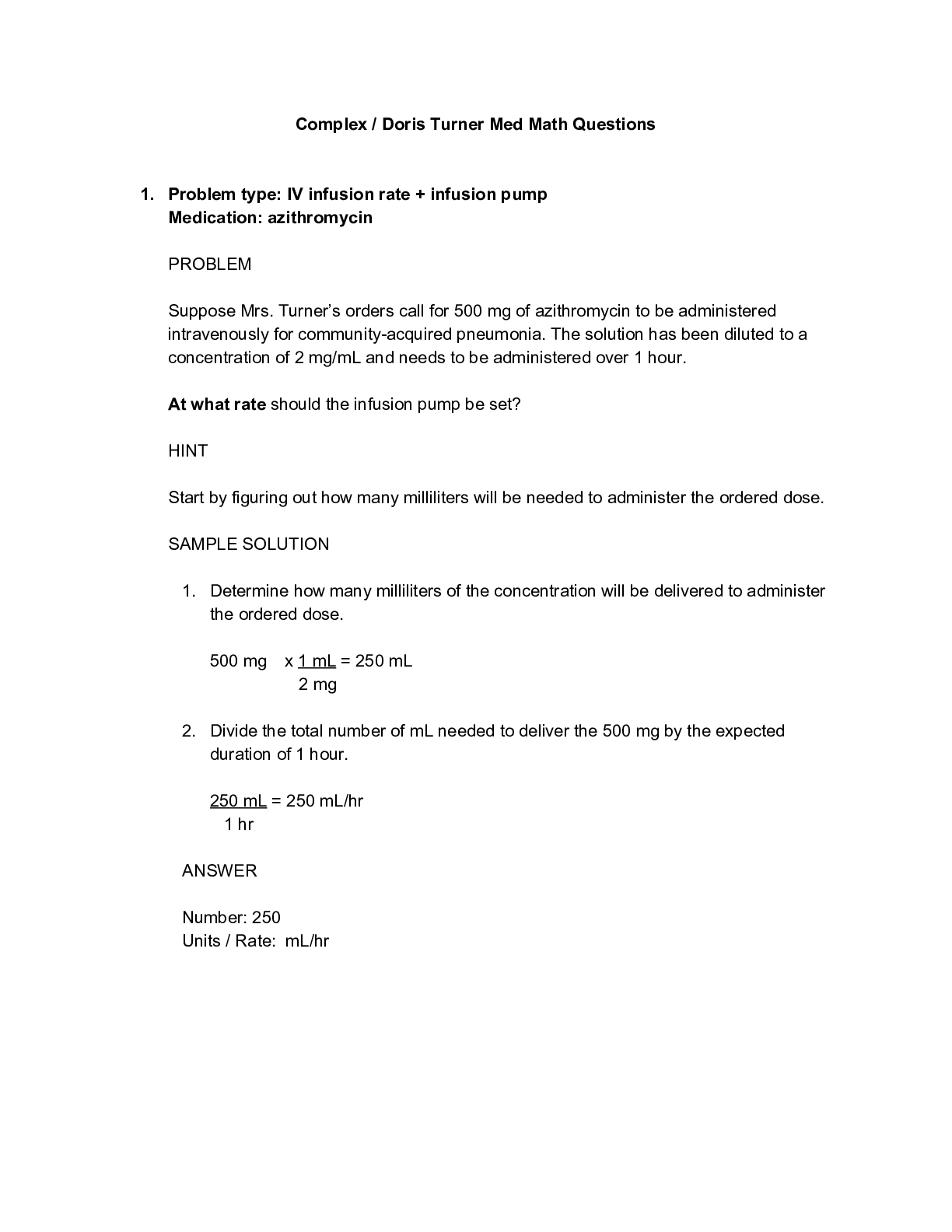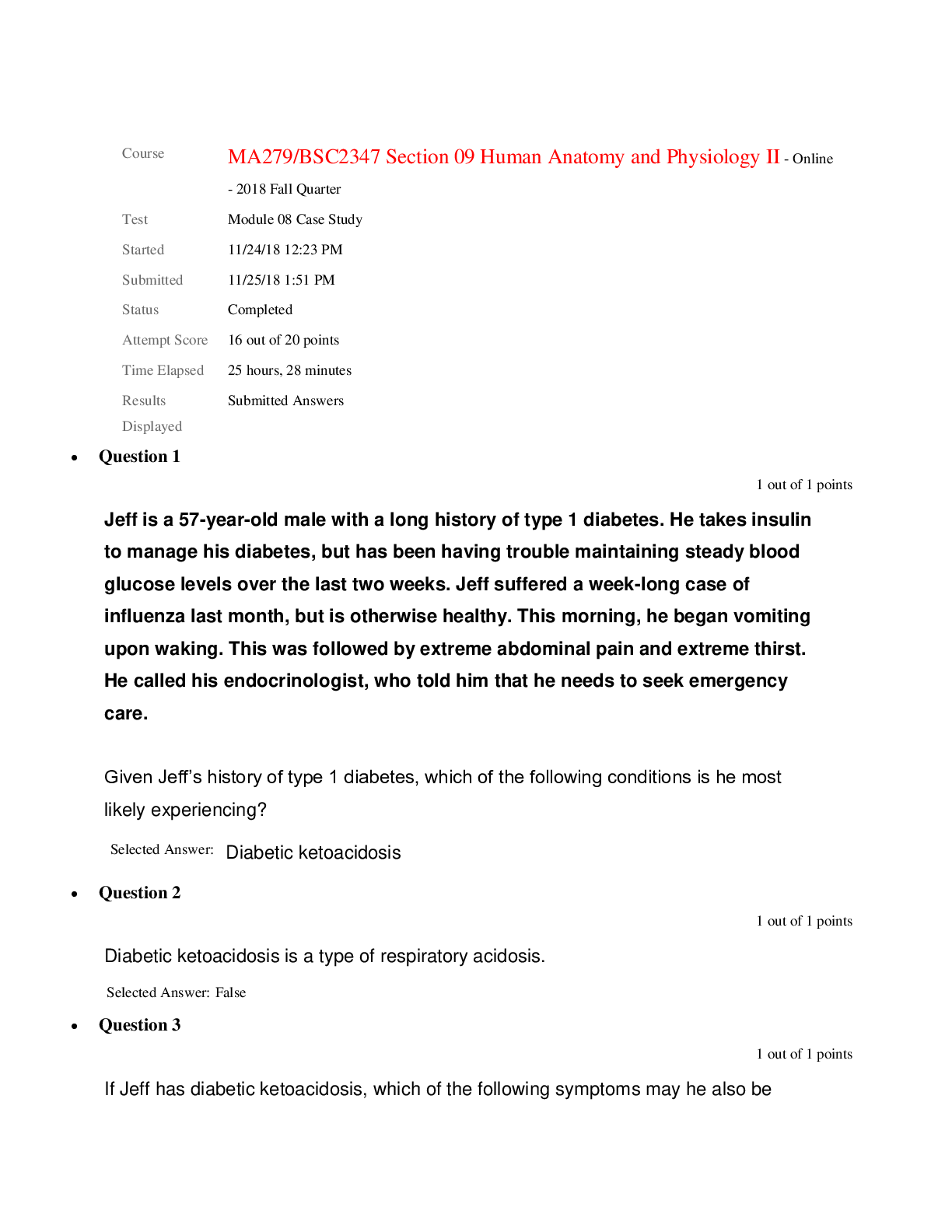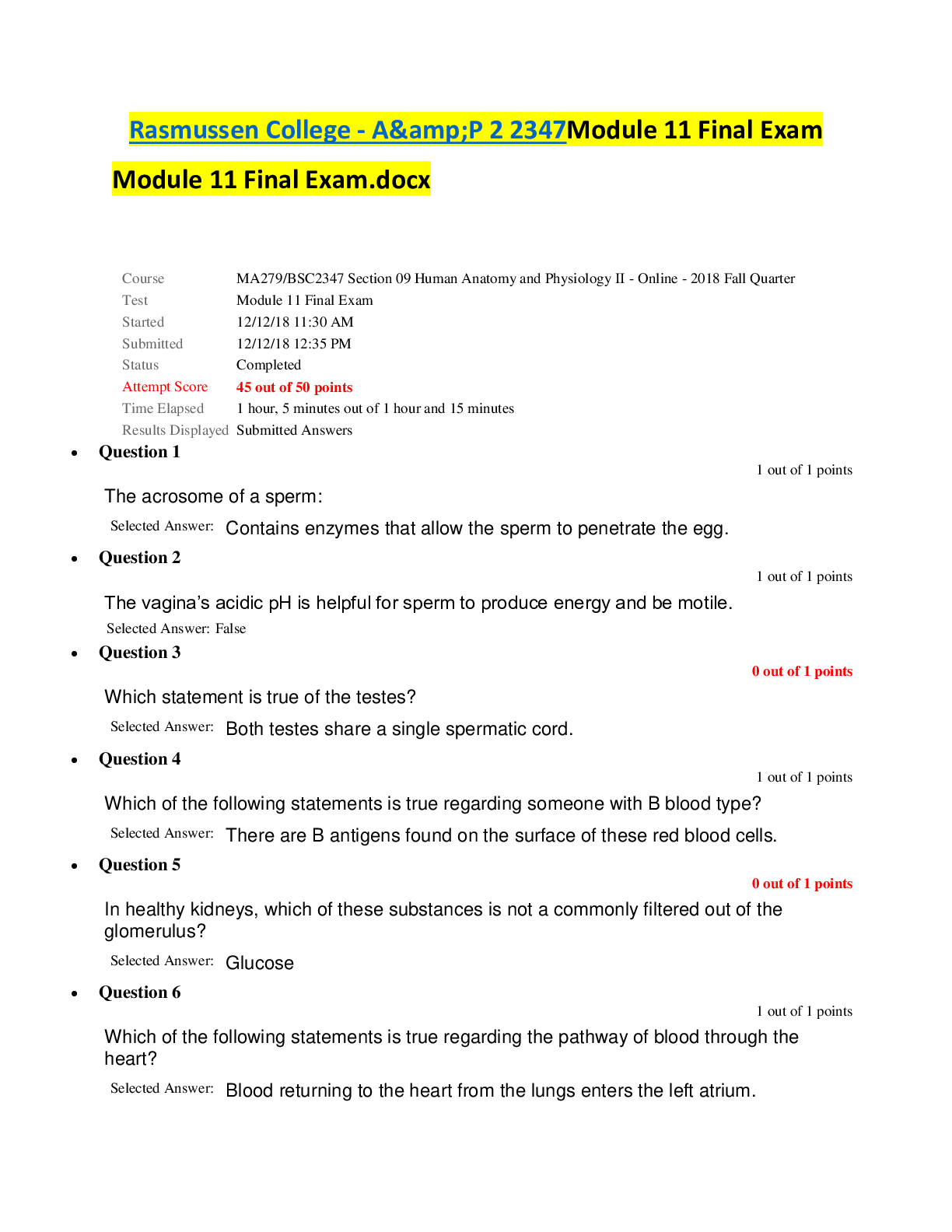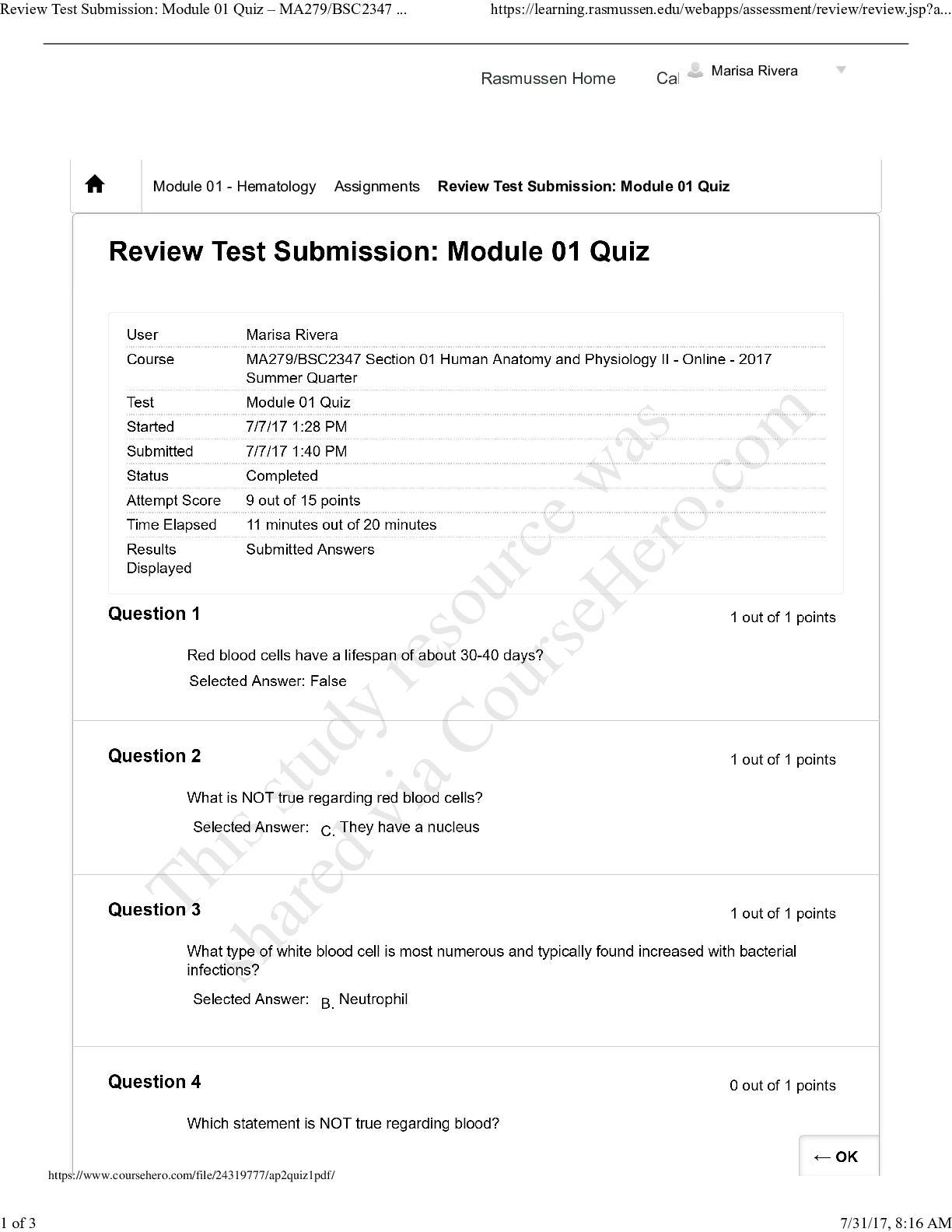Physiology > QUESTIONS & ANSWERS > Holes Human Anatomy and Physiology 13th Edition David Shier: TestBanks (All)
Holes Human Anatomy and Physiology 13th Edition David Shier: TestBanks
Document Content and Description Below
Multiple Choice Questions 1. Chemistry deals with A. the composition and changes of substances that make up living as well as non-living matter. B. the composition and changes of substances found ... in organisms only. C. the composition of and changes of substances that make up non-living matter only. D. the location of organs in body cavities. Bloom's Level: 2. Understand Learning Outcome: 02.01 Topic: Chemistry 2. Chemistry is important to the study of physiology because A. the foods that we eat are chemicals. B. body functions depend on cellular functions that reflect chemical changes. C. chemical reactions enable our bodies to extract energy from nutrients. D. all of the above. Bloom's Level: 2. Understand Learning Outcome: 02.01 Topic: Chemistry 2-2 3. Which of the following substances is an element? A. Iron B. Water C. Sodium chloride D. Glucose Bloom's Level: 2. Understand Learning Outcome: 02.02 Topic: Chemistry 4. Which of the following groups of elements account for more than 95% of the human body by weight? A. Carbon, hydrogen, oxygen, nitrogen B. Calcium, hydrogen, oxygen, nitrogen C. Carbon, phosphorus, oxygen, hydrogen D. Calcium, phosphorus, hydrogen, nitrogen Bloom's Level: 1. Remember Learning Outcome: 02.02 Topic: Chemistry 5. The atoms of different elements have A. the same atomic number and same atomic weight. B. the same atomic number but different atomic weights. C. different atomic numbers. D. different atomic numbers but the same number of electrons. Bloom's Level: 2. Understand Learning Outcome: 02.02 Topic: Chemistry 2-3 6. Isotopes of an element have A. the same atomic number and same atomic weight. B. the same atomic number but different atomic weights. C. different atomic numbers but the same atomic weight. D. different atomic numbers and different atomic weights. Bloom's Level: 1. Remember Learning Outcome: 02.02 Topic: Chemistry 7. Which of the following is(are) ionizing radiation? A. Cosmic radiation only B. Gamma radiation only C. Both cosmic radiation and gamma radiation D. Neither cosmic nor gamma radiation Bloom's Level: 1. Remember Learning Outcome: 02.02 Topic: Chemistry 8. The atomic weight of an element whose atoms contain 8 protons, 8 electrons, and 8 neutrons is A. 8. B. 16. C. 24. D. 32. Bloom's Level: 3. Apply Learning Outcome: 02.02 Topic: Chemistry 2-4 9. The atoms of the isotopes of a particular element vary in the number of A. electrons. B. protons. C. neutrons. D. nuclei. Bloom's Level: 2. Understand Learning Outcome: 02.02 Topic: Chemistry 10. The first electron shell of an atom can hold a maximum of A. 1 electron. B. 2 electrons. C. 4 electrons. D. 8 electrons. Bloom's Level: 1. Remember Learning Outcome: 02.02 Topic: Chemistry 11. When forming a bond, an atom that has 3 electrons in its second shell and a filled first shell will A. lose 3 electrons from its second shell. B. lose all of the electrons from its first shell. C. lose all of the electrons from both its first and second shells. D. gain 5 electrons in its second shell. Bloom's Level: 3. Apply Learning Outcome: 02.02 Topic: Chemistry 2-5 12. The formula H2O refers to A. Two hydrogen molecules and one oxygen molecule. B. One hydrogen molecule and two oxygen molecules. C. A molecule that contains two hydrogen atoms and one oxygen atom. D. A molecule that contains one hydrogen atom and two oxygen atoms. Bloom's Level: 2. Understand Learning Outcome: 02.02 Topic: Chemistry 13. A decomposition reaction can be symbolized by A. A + B C + D. B. A + B AB. C. AB A + B. D. C + D AB. Bloom's Level: 1. Remember Learning Outcome: 02.02 Topic: Chemistry 14. A water solution that contains equal numbers of hydrogen ions and hydroxide ions is A. acidic. B. basic. C. alkaline. D. neutral. Bloom's Level: 2. Understand Learning Outcome: 02.02 Topic: Chemistry 2-6 15. Electrolytes that release hydrogen ions in water are A. bases. B. nucleotides. C. acids. D. electrons. Bloom's Level: 2. Understand Learning Outcome: 02.02 Topic: Chemistry 16. The difference in hydrogen ion concentration between solutions with pH 4 and pH 5 is A. twofold. B. fivefold. C. tenfold. D. twentyfold. Bloom's Level: 2. Understand Learning Outcome: 02.02 Topic: Chemistry 17. A chemical reaction in which parts of different molecules trade positions is a(n) A. decomposition reaction. B. exchange reaction. C. reversible reaction. D. synthesis reaction. Bloom's Level: 1. Remember Learning Outcome: 02.02 Topic: Chemistry 2-7 18. Consider the following list of commonly found items and their pH values: Which of the choices includes all acids? A. Egg whites, baking soda, milk of magnesia, and bleach B. Tomatoes, egg whites, and baking soda C. Vinegar, grapes, tomatoes, and coffee D. Beer, butter, and baking soda Bloom's Level: 3. Apply Learning Outcome: 02.02 Topic: Chemistry 19. Electrolytes are substances that A. form covalent bonds with water. B. ionize in water. C. cannot conduct electricity in solution. D. form bonds that are stable in water. Bloom's Level: 2. Understand Learning Outcome: 02.02 Topic: Chemistry 2-8 20. The pH scale measures the A. concentration of hydrogen ions in solution. B. number of molecules of salts dissolved in water. C. number of hydroxide ions in water. D. strength of an electrical current that a solution carries. Bloom's Level: 1. Remember Learning Outcome: 02.02 Topic: Chemistry 21. Which of the following is the most abundant inorganic substance in the body? A. Carbohydrate B. Water C. Lipid D. Protein Bloom's Level: 2. Understand Learning Outcome: 02.03 Topic: Chemistry 22. A person has alkalosis if the blood pH A. is above 7.0. B. is below 7.0. C. rises above 7.5. D. drops below 7.3. Bloom's Level: 2. Understand Learning Outcome: 02.02 Topic: Chemistry 2-9 23. Matter is composed of elements, which are composed of . A. atoms B. inorganic molecules C. organic molecules D. chemicals Bloom's Level: 2. Understand Learning Outcome: 02.02 Topic: Chemistry 24. A complete atom is electrically neutral because the number of A. protons and neutrons are equal. B. electrons and neutrons are equal. C. electrons and protons are equal. D. electrons is greater than the number of protons. Bloom's Level: 2. Understand Learning Outcome: 02.02 Topic: Chemistry 25. The atomic number of an atom equals the number of and the atomic weight equals the . A. neutrons; number of protons B. protons; weight of all the electrons C. neutrons; number of protons plus electrons D. protons; number of protons plus neutrons Bloom's Level: 2. Understand Learning Outcome: 02.02 Topic: Chemistry [Show More]
Last updated: 2 years ago
Preview 1 out of 34 pages
 (1).png)
Buy this document to get the full access instantly
Instant Download Access after purchase
Buy NowInstant download
We Accept:

Reviews( 0 )
$17.00
Can't find what you want? Try our AI powered Search
Document information
Connected school, study & course
About the document
Uploaded On
Apr 30, 2021
Number of pages
34
Written in
Additional information
This document has been written for:
Uploaded
Apr 30, 2021
Downloads
0
Views
51
























, 100% Correct, Download to Score A.png)

